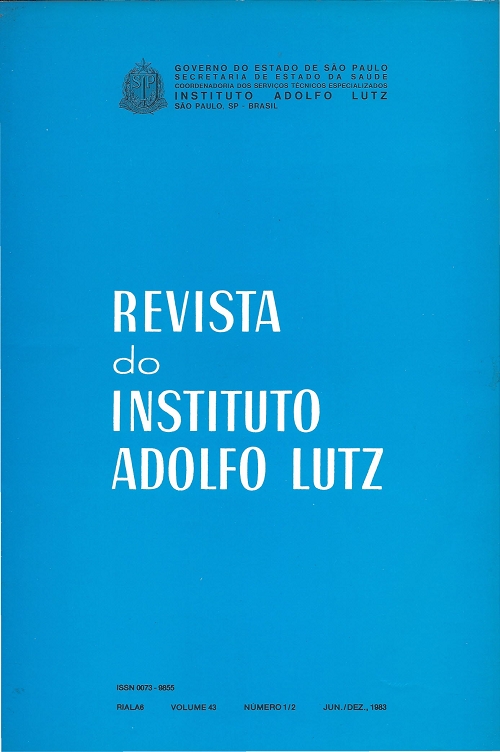Abstract
Atomic absorption spectrophotometry was employed for determination of the cadmium content of sea foods obtained in three places of Brazil's seashore: the bays of Santos (state of São Paulo), Guanabara (state of Rio de Janeiro) and Todos os Santos (state of Bahia). Less than 0.03 mg/kg of cadmium was found in 90% of 161 samples of which 85.7% was < 0.01 mg/kg. The mineralization of samples was ma de by dry-ashing.
References
1. BRASIL. Leis, decretos, etc. Decreto nº 55.871 de 26 mar. 1965. Diário Oficial.
Brasília, 9 abro 1965. Seç. I, pt. I, p. 3611. Modifica o Decreto nº 50.040, de 24 jan. 1961, referente a normas reguladoras do emprego de aditivos para alimentos, alterado pelo Decreto nº 691, de 13 de mar. 1962.
2. COMISSION OF THE EUROPEAN COMMUNITIES Criteria (dose/effect relationships) for cadmio. Report of a Working Group of Experts. Oxford, Pergamon press, 1978. 202 p. [EUR 5697]
3. COMPANHIA DE TECNOLOGIA DE SANEAMENTO AMBIENTAL Metais pesados no Estuário e Baía de Santos. [São Paulo] 1980. 75 p.
4. ECHEGARAY, R. M. & CHANG-SAY, Y., J. - Contenido de algunos metales pesados en especies marinas peruanas. Rev. Salud Ocupae., 18 :5-24, 1973.
5. FOOD AGRICULTURE ORGANIZATION - Methods of sampling and analysis of eontaminants in food. Report of a Joint FAO/WHO Expert Consultation, Rome,
1976. Rome, FAO/WHO, 1976. [FAO Food ControI Series n. 3 / WHO Food
Control n. 3]
6. GLOBAL ENVIRONMENTAL MONITORING SYSTEM. Joint FAO/WHO Foodand Animal Feed Contamination Programme - Summary and assessment of data reeeived from the FAO/WHO Collaborating Centres for Food Contamination M onitoring. Uppsala, National Food Administration, 1982. p. 41-43.
7. HOENING, M.; LIMA, C. & DUPIRE, S. - Validity of the AAS determination of Cd, Co, Cr, Ni and Pb in animal tis sues, especially in fish and fish organs. Analusis, 10(3) :132-9, 1982 apud Food Sei. Technol. Abst., 15(3): 189, 1983. [3 R 251]
8. INTERNATIONAL AGENCY FOR RESEARCH OF CANCER - Evaluation of earcinogenio risk of chemicals to man; Cd, Ni, some eposeides, miscellaneous, industrial chemieals and general eonsiderations on volatile anaestheties. Lyon, lAR C, 1976. V. 2, p. 39-74. [lAR C monogr. n. 2]
9. ITÁLIA. Leis, decretos etc. Decreto ministeriale 14 diciembre 1971. G.U. n. 328 deI 28 diciembre 1971. Lex 1971, parte I, pago 4050. Limite di contamíraziorie da mercurio deI pesce e deglialtri prodotti alimentari della pesca di provenienza estera.
10. SOMMERS, E. - The toxic potential of trace metaIs in foods. A review. J. Food Sei., 39:215-7, 1974.
11. WORLD HEALTH ORGANIZATION. Jont FAO/WHO Expert Committee on Food Additives, Geneve, 1972. Evaluation of mereury, lead, eadmium and the food
additives amaranth, diethylpyroearbonate, and oetyl gallate. Geneva, WHO, 1972.
p. 51-66. [WHO Food Additives Ser. n. 4]
Brasília, 9 abro 1965. Seç. I, pt. I, p. 3611. Modifica o Decreto nº 50.040, de 24 jan. 1961, referente a normas reguladoras do emprego de aditivos para alimentos, alterado pelo Decreto nº 691, de 13 de mar. 1962.
2. COMISSION OF THE EUROPEAN COMMUNITIES Criteria (dose/effect relationships) for cadmio. Report of a Working Group of Experts. Oxford, Pergamon press, 1978. 202 p. [EUR 5697]
3. COMPANHIA DE TECNOLOGIA DE SANEAMENTO AMBIENTAL Metais pesados no Estuário e Baía de Santos. [São Paulo] 1980. 75 p.
4. ECHEGARAY, R. M. & CHANG-SAY, Y., J. - Contenido de algunos metales pesados en especies marinas peruanas. Rev. Salud Ocupae., 18 :5-24, 1973.
5. FOOD AGRICULTURE ORGANIZATION - Methods of sampling and analysis of eontaminants in food. Report of a Joint FAO/WHO Expert Consultation, Rome,
1976. Rome, FAO/WHO, 1976. [FAO Food ControI Series n. 3 / WHO Food
Control n. 3]
6. GLOBAL ENVIRONMENTAL MONITORING SYSTEM. Joint FAO/WHO Foodand Animal Feed Contamination Programme - Summary and assessment of data reeeived from the FAO/WHO Collaborating Centres for Food Contamination M onitoring. Uppsala, National Food Administration, 1982. p. 41-43.
7. HOENING, M.; LIMA, C. & DUPIRE, S. - Validity of the AAS determination of Cd, Co, Cr, Ni and Pb in animal tis sues, especially in fish and fish organs. Analusis, 10(3) :132-9, 1982 apud Food Sei. Technol. Abst., 15(3): 189, 1983. [3 R 251]
8. INTERNATIONAL AGENCY FOR RESEARCH OF CANCER - Evaluation of earcinogenio risk of chemicals to man; Cd, Ni, some eposeides, miscellaneous, industrial chemieals and general eonsiderations on volatile anaestheties. Lyon, lAR C, 1976. V. 2, p. 39-74. [lAR C monogr. n. 2]
9. ITÁLIA. Leis, decretos etc. Decreto ministeriale 14 diciembre 1971. G.U. n. 328 deI 28 diciembre 1971. Lex 1971, parte I, pago 4050. Limite di contamíraziorie da mercurio deI pesce e deglialtri prodotti alimentari della pesca di provenienza estera.
10. SOMMERS, E. - The toxic potential of trace metaIs in foods. A review. J. Food Sei., 39:215-7, 1974.
11. WORLD HEALTH ORGANIZATION. Jont FAO/WHO Expert Committee on Food Additives, Geneve, 1972. Evaluation of mereury, lead, eadmium and the food
additives amaranth, diethylpyroearbonate, and oetyl gallate. Geneva, WHO, 1972.
p. 51-66. [WHO Food Additives Ser. n. 4]

This work is licensed under a Creative Commons Attribution 4.0 International License.
Copyright (c) 1983 Instituto Adolfo Lutz Journal
Downloads
Download data is not yet available.
